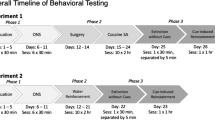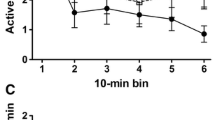Abstract
Rationale
The ability of locomotor activity in a novel environment (Loco) and visual stimulus reinforcement (VSR) to predict acquisition of responding for cocaine and water reinforcers in the absence of explicit audiovisual signals was evaluated.
Methods
In Experiment 1 (Exp 1), rats (n = 60) were tested for VSR, followed by Loco, and finally acquisition of responding for cocaine (0.3 mg/kg/inf). In Experiment 2 (Exp 2), rats (n = 32) were tested for VSR, followed by Loco, and finally acquisition of responding for water (0.01 mL/reinforcer).
Results
There were three main findings. First, Loco and VSR were significantly associated (Exp 1: r = 0.49, p < 0.00; Exp 2: r = 0.35, p < 0.05). Second, neither Loco (r = .00, p = 0.998) nor VSR (r = −0.12, p = 0.352) predicted acquisition of cocaine SA. Third, in the subgroup of animals that acquired cocaine SA, VSR (r = 0.41, p < 0.01) but not Loco (r = 0.28, p = 0.10) was positively associated with operant responding for cocaine. Both Loco and VSR (Loco: r = 0.37, p < 0.04; VSR: r = 0.51, p < 0.00) were positively associated with operant responding for water reinforcers.
Conclusions
The results indicate that VSR is at least as good a predictor of cocaine reinforced responding as Loco. VSR was predictive of operant responding for both drug and water reinforcers, while Loco was found to be predictive of responding only for water reinforcers. In studies that present visual stimuli in association with drug delivery, Loco may be predicting acquisition of responding for VSR rather than drug.








Similar content being viewed by others
References
Abbott B, Badia P (1979) Choice for signaled over unsignaled shock as a function of signal length. J Exp Anal Behav 32:409–417
Andrucci GL, Archer RP, Pancoast DL, Gordon RA (1989) The relationship of MMPI and sensation seeking scales to adolescent drug use. J Pers Assess 53:253–266
Badia P, Harsh J, Coker CC, Abbott B (1976) Choice and the dependability of stimuli that predict shock and safety. J Exp Anal Behav 26:95–111
Bornovalova MA, Cashman-Rolls A, O’Donnell JM, Ettinger K, Richards JB, deWit H, Lejuez CW (2009) Risk taking differences on a behavioral task as a function of potential reward/loss magnitude and individual differences in impulsivity and sensation seeking. Pharmacol Biochem Behav 93:258–262
Caggiula AR, Donny EC, Chaudhri N, Perkins KA, Evans-Martin FF, Sved AF (2002a) Importance of nonpharmacological factors in nicotine self-administration. Physiol Behav 77:683–687
Caggiula AR, Donny EC, Palmatier MI, Liu X, Chaudhri N, Sved AF (2009) The role of nicotine in smoking: a dual-reinforcement model. Nebr Symp Motiv 55:91–109
Caggiula AR, Donny EC, White AR, Chaudhri N, Booth S, Gharib MA, Hoffman A, Perkins KA, Sved AF (2001) Cue dependency of nicotine self-administration and smoking. Pharmacol Biochem Behav 70:515–530
Caggiula AR, Donny EC, White AR, Chaudhri N, Booth S, Gharib MA, Hoffman A, Perkins KA, Sved AF (2002b) Environmental stimuli promote the acquisition of nicotine self-administration in rats. Psychopharmacol (Berl) 163:230–237
Cain ME, Denehy ED, Bardo MT (2008) Individual differences in amphetamine self-administration: the role of the central nucleus of the amygdala. Neuropsychopharmacology 33:1149–1161
Chaudhri N, Caggiula AR, Donny EC, Booth S, Gharib M, Craven L, Palmatier MI, Liu X, Sved AF (2007) Self-administered and noncontingent nicotine enhance reinforced operant responding in rats: impact of nicotine dose and reinforcement schedule. Psychopharmacol (Berl) 190:353–362
Chaudhri N, Caggiula AR, Donny EC, Palmatier MI, Liu X, Sved AF (2006) Complex interactions between nicotine and nonpharmacological stimuli reveal multiple roles for nicotine in reinforcement. Psychopharmacology (Berl) 184:353–366
Davis BA, Clinton SM, Akil H, Becker JB (2008) The effects of novelty-seeking phenotypes and sex differences on acquisition of cocaine self-administration in selectively bred high-responder and low-responder rats. Pharmacol Biochem Behav 90:331–338
Dellu F, Mayo W, Piazza PV, Le Moal M, Simon H (1993) Individual differences in behavioral responses to novelty in rats. Possible relationship with the sensation-seeking trait in man. Personal Individ Differ 4:411–418
Dellu F, Piazza PV, Mayo W, Le Moal M, Simon H (1996) Novelty-seeking in rats—biobehavioral characteristics and possible relationship with the sensation-seeking trait in man. Neuropsychobiology 34:136–145
Deroche-Gamonet V, Piat F, Le Moal M, Piazza PV (2002) Influence of cue-conditioning on acquisition, maintenance and relapse of cocaine intravenous self-administration. Eur J Neurosci 15:1363–1370
Deroche V, Piazza PV, Le Moal M, Simon H (1993) Individual differences in the psychomotor effects of morphine are predicted by reactivity to novelty and influenced by corticosterone secretion. Brain Res 623:341–344
Donny EC, Caggiula AR, Mielke MM, Jacobs KS, Rose C, Sved AF (1998) Acquisition of nicotine self-administration in rats: the effects of dose, feeding schedule, and drug contingency. Psychopharmacol (Berl) 136:83–90
Donny EC, Chaudhri N, Caggiula AR, Evans-Martin FF, Booth S, Gharib MA, Clements LA, Sved AF (2003) Operant responding for a visual reinforcer in rats is enhanced by noncontingent nicotine: implications for nicotine self-administration and reinforcement. Psychopharmacol (Berl) 169:68–76
Estes WK, Skinner BF (1942) Some quantitative properties of anxiety. J Exp Psychol 29:390–400
Ettenberg A, Geist TD (1991) Animal model for investigating the anxiogenic effects of self-administered cocaine. Psychopharmacol (Berl) 103:455–461
Gancarz AM (2011) Sensory reinforcement as an animal model of sensation seeking: strength of association to cocaine self-administration. (Doctoral dissertation). Retrieved from ProQuest Dissertations and Theses. (Accession Order No. 3460752)
Gancarz AM, Ashrafioun L, San George MA, Hausknecht KA, Hawk LW Jr, Richards JB (2011a) Exploratory studies in sensory reinforcement: effects of methamphetamine. Exp Clin Psychopharmacol 20:16–27
Gancarz AM, Kausch MA, Lloyd DR, Richards JB (2012a) Between-session progressive ratio performance in rats responding for cocaine and water reinforcers. Psychopharmacol (Berl) 222(2):215–223
Gancarz AM, Robble MA, Kausch MA, Richards JB (2012b) Association between locomotor response to novelty and light reinforcement: sensory reinforcement as an animal model of sensation seeking. Behav Brain Res 230:380–388
Gancarz AM, San George MA, Ashrafioun L, Richards JB (2011b) Locomotor activity in a novel environment predicts both responding for a visual stimulus and self-administration of a low dose of methamphetamine in rats. Behav Processes 86:295–304
Grimm JW, See RE (1997) Cocaine self-administration in ovariectomized rats is predicted by response to novelty, attenuated by 17-beta estradiol, and associated with abnormal vaginal cytology. Physiol Behav 61:755–761
Klebaur JE, Bevins RA, Segar TM, Bardo MT (2001) Individual differences in behavioral responses to novelty and amphetamine self-administration in male and female rats. Behav Pharmacol 12:267–275
Marinelli M, White FJ (2000) Enhanced vulnerability to cocaine self-administration is associated with elevated impulse activity of midbrain dopamine neurons. J Neurosci 20:8876–8885
Mitchell JM, Cunningham CL, Mark GP (2005) Locomotor activity predicts acquisition of self-administration behavior but not cocaine intake. Behav Neurosci 119:464–472
Olsen CM (2011) Natural rewards, neuroplasticity, and non-drug addictions. Neuropharmacology 61:1109–1122
Olsen CM, Winder DG (2009) Operant sensation seeking engages similar neural substrates to operant drug seeking in C57 mice. Neuropsychopharmacology 34:1685–1694
Palmatier MI, Evans-Martin FF, Hoffman A, Caggiula AR, Chaudhri N, Donny EC, Liu X, Booth S, Gharib M, Craven L, Sved AF (2006) Dissociating the primary reinforcing and reinforcement-enhancing effects of nicotine using a rat self-administration paradigm with concurrently available drug and environmental reinforcers. Psychopharmacol (Berl) 184:391–400
Piazza PV, Deminiere JM, Le Moal M, Simon H (1989) Factors that predict individual vulnerability to amphetamine self-administration. Science 245:1511–1513
Piazza PV, Deminiere JM, Maccari S, Mormede P, Le Moal M, Simon H (1990) Individual reactivity to novelty predicts probability of amphetamine self-administration. Behav Pharmacol 1:339–345
Piazza PV, Deroche-Gamonent V, Rouge-Pont F, Le Moal M (2000) Vertical shifts in self-administration dose–response functions predict a drug-vulnerable phenotype predisposed to addiction. J Neurosci 20:4226–4232
Piazza PV, Deroche V, Deminiere JM, Maccari S, Le Moal M, Simon H (1993a) Corticosterone in the range of stress-induced levels possesses reinforcing properties: implications for sensation-seeking behaviors. Proc Natl Acad Sci U S A 90:11738–11742
Piazza PV, Mittleman G, Deminiere JM, Le Moal M, Simon H (1993b) Relationship between schedule-induced polydipsia and amphetamine intravenous self-administration. Individual differences and role of experience. Behav Brain Res 55:185–193
Riley AL (2011) The paradox of drug taking: the role of the aversive effects of drugs. Physiol Behav 103:69–78
Seligman ME (1968) Chronic fear produced by unpredictable electric shock. J Comp Physiol Psychol 66:402–411
Seligman ME, Meyer B (1970) Chronic fear and ulcers in rats as a function of the unpredictability of safety. J Comp Physiol Psychol 73:202–207
Sutker PB, Archer RP, Allain AN (1978) Drug abuse patterns, personality characteristics, and relationships with sex, race, and sensation seeking. J Consult Clin Psychol 46:1374–1378
Twining RC, Bolan M, Grigson PS (2009) Yoked delivery of cocaine is aversive and protects against the motivation for drug in rats. Behav Neurosci 123:913–925
Weiss JM (1970) Somatic effects of predictable and unpredictable shock. Psychosom Med 32:397–408
Weiss JM, Krieckhaus EE, Conte R (1968) Effects of fear conditioning on subsequent avoidance behavior and movement. J Comp Physiol Psychol 65:413–421
Acknowledgments
This work was conducted in partial fulfillment of the requirements of a doctoral degree at the State University of New York at Buffalo for Amy M. Gancarz. We would like to thank Linda Beyley for her assistance in conducting the experiments and Mark Kogutowski for his technical expertise in computer programming for the current experiments. We wish to thank Drs. Michael Bozarth, Micheal Dent, and Larry Hawk for their critical comments and editorial assistance on earlier versions of the manuscript. This work was partly supported by DA10588 to Jerry B. Richards. Amy M. Gancarz was supported by NIAAA training grant T32-AA007583-11 during the preparation of the manuscript. Amy M. Gancarz was supported by NIAAA training grant T32-AA007583-11 during the preparation of the manuscript. The cocaine tested in these experiments was gifted by NIDA. The authors on this manuscript reported no biomedical financial interests or potential conflicts of interest.
Author information
Authors and Affiliations
Corresponding author
Rights and permissions
About this article
Cite this article
Gancarz, A.M., Robble, M.A., Kausch, M.A. et al. Sensory reinforcement as a predictor of cocaine and water self-administration in rats. Psychopharmacology 226, 335–346 (2013). https://doi.org/10.1007/s00213-012-2907-6
Received:
Accepted:
Published:
Issue Date:
DOI: https://doi.org/10.1007/s00213-012-2907-6




